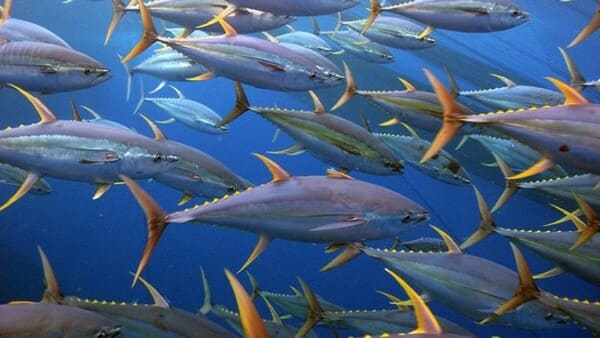Introduction
Tuna is a popular and widely recognized species of fish known for its delicious taste and significant economic importance in the world of seafood.
Because of their high economic value, more and more fishermen or fishing company are focus on fishing tuna. But they are fast-swimming, it is not easy to catch them efficiently. So you need know the types of fishing net for tuna.
The most popular fishing net for tuna is purse seine net. Let’s talk about all of them in this blog, hope it can be helpful for you.
Types of tuna
Before that, let’s talk about the types of tuna.
Tuna is not just one kind of fish. There are several species of tuna, each with its own characteristics and culinary appeal.
The most well-known types of tuna include bluefin tuna, yellowfin tuna, bigeye tuna, skipjack tuna, albacore tuna and Bonito.
Bluefin Tuna
Bluefin tuna are among the largest and most prized species of tuna. They are known for their deep blue to black coloring on the upper body and silvery-white underside.

Bluefin tuna can grow to be exceptionally large, with some individuals reaching weights exceeding 1,000 kilograms (2,200 pounds). Due to their size and delicious meat, bluefin tuna are highly valued in the sushi and sashimi markets.
They are further categorized into three subspecies: Atlantic bluefin, Pacific bluefin, and Southern bluefin.
Yellowfin Tuna
Yellowfin tuna are also known as thunnus albacares, they are known for their distinctive yellow finlets and yellow dorsal fin. They have a streamlined body with metallic blue-black coloring on their upper bodies.
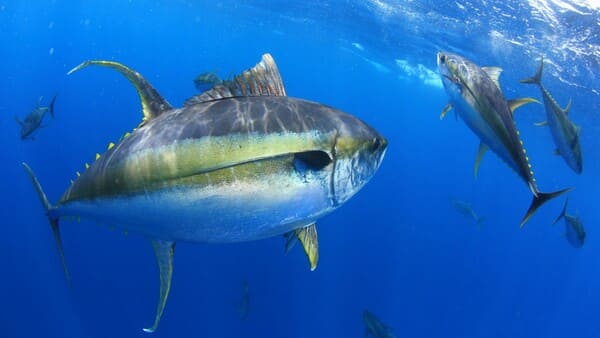
Yellowfin tuna are prized for their firm, flavorful flesh, and they are commonly used in a variety of dishes, including sushi and grilled preparations.
Bigeye Tuna
Bigeye tuna are also known as thunnus obesus, they are named for their relatively large eyes, which give them excellent vision in low-light conditions.
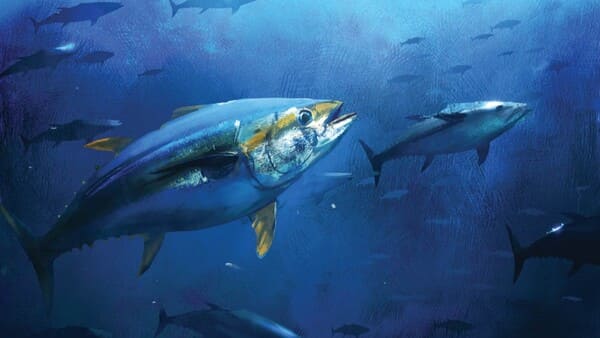
They have deep red flesh and are often used in sashimi and sushi dishes. Bigeye tuna are typically found in warmer waters and are known for their strong, fight during fishing.
Skipjack Tuna
Skipjack tuna are also known as katsuwonus pelamis, they are smaller in size compared to some other tuna species and are recognized by their distinct dark stripes running along their backs.

They have light-colored flesh and are commonly used in canned tuna products, as well as in sushi rolls and salads.
Albacore Tuna
Albacore tuna are also called as thunnus alalunga, they have a more slender body compared to some other tuna species and are recognized by their long pectoral fins.
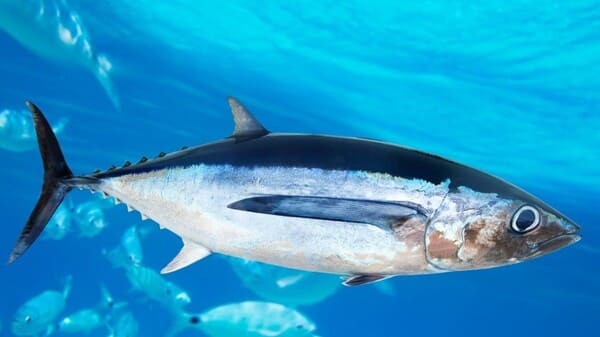
They have white flesh with a mild flavor and are often used in canned tuna products, as well as in sandwiches and salads.
Bonito
Bonito is also known as sarda, it is also known as is a name used for several species of smaller tuna, such as the Atlantic bonito and the Pacific bonito.

They are usually around the same size as skipjack tuna and are known for their dark striping and flavorful meat.
What is the best fishing net for tuna
Purse seine net is the most popular fishing net to catch the tuna in the market. You can see the details about purse seine in HERE.
Purse seine is a specialized fishing net designed to capture tuna, especially large species like yellowfin and skipjack tuna. This type of purse seine is a crucial tool in the commercial tuna fishing industry, allowing fishermen to target and harvest tuna efficiently.
Why is purse seine
The purse seine is widely used in commercial fishing industry, because it has many benefits in catch fish, especially tuna.
High Efficiency
Purse seine nets can encircle and capture entire schools of tuna in a single haul, making it highly efficient for catching large quantities of tuna at once. This efficiency is particularly valuable for species like skipjack tuna, which often swim in large schools.
Reduced Bycatch
Purse seine nets can be used selectively to reduce the capture of non-target species, such as dolphins and juvenile tuna, when properly deployed with appropriate techniques and equipment.
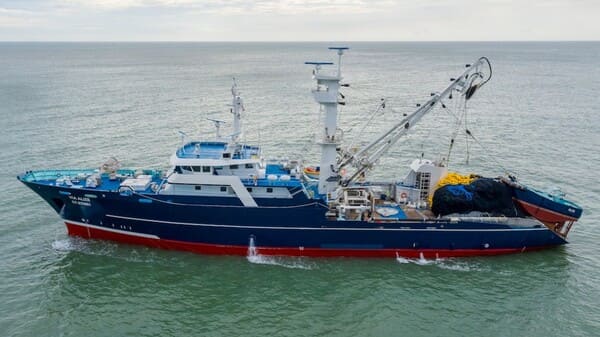
Cost-Effectiveness
Purse seine fishing can be cost-effective for commercial operations because it allows for a high yield of target species in a single catch, reducing the cost per ton of tuna caught.
Suitability for Tuna
Some tuna species, like skipjack and juvenile yellowfin tuna, tend to swim closer to the surface, making them well-suited for purse seine fishing.
what do you need before fishing
Catching tuna using a purse seine net requires a skilled fishing team and specialized equipment. The fishing vessel and crew must work together efficiently to successfully capture and harvest tuna.
Purse Seiner Vessel
At first, you should have a professional purse seiner. A purse seiner is typically a large fishing vessel designed for open-ocean fishing.
The vessel is equipped with the necessary gear for purse seine fishing, including the purse seine net, winches, hydraulic systems, and refrigerated storage for the caught fish.
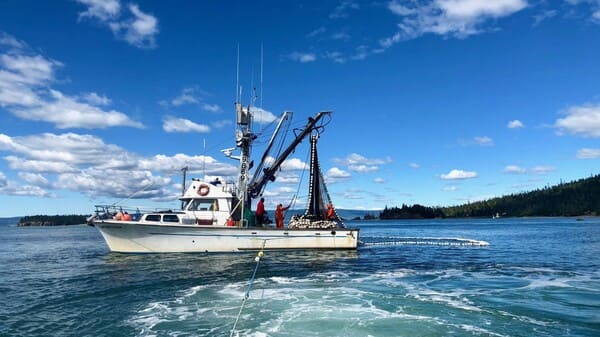
It may have a crane for deploying and recovering the net and other equipment like Fish Aggregating Devices (FADs) for locating tuna schools.
Skilled Fishing Team
The purse seine fishing is not an easy work, it should be operated by a professional team. So you must have a skilled team for fishing.
Captain
The captain is responsible for overall vessel operations, navigation, and decision-making. They determine when and where to deploy the purse seine and ensure the safety of the crew.
Fish Master
The fish master is a highly experienced individual responsible for coordinating the fishing operations. They make crucial decisions during the catch, such as when to close the purse line.

Helmsman
The helmsman is in charge of steering the vessel and maneuvering it to encircle the tuna school. They work closely with the fish master to position the vessel correctly.
Deck Crew
The deck crew are responsible for handling the purse seine net. They assist in deploying, drawing in, and securing the net, ensuring it encircles the tuna school effectively.
Winch Operators
Skilled winch operators manage the winches or hydraulic systems used to control the purse line. They control the tension and speed of the purse line to close the net properly.
Spotter Plane Crew
In some operations, a spotter plane may be used to locate tuna schools from the air. The plane’s crew communicates with the fishing vessel to guide it to the target area.
Safety Personnel
Safety personnel are responsible for the safety of the crew. They ensure that all crew members follow safety protocols, especially when handling heavy equipment.
What is the purse seine process
Here are several steps of process to use the purse seine for your reference.
Spotting the Tuna School
The skilled team uses various tools, including sonar, radar, visual observation, and potentially a spotter plane, to locate the target tuna school.
Deployment
The purse seine net is deployed from the vessel, creating a large, floating barrier in the water.
Encircling the School
The vessel maneuvers to encircle the school of tuna with the deployed purse seine net.
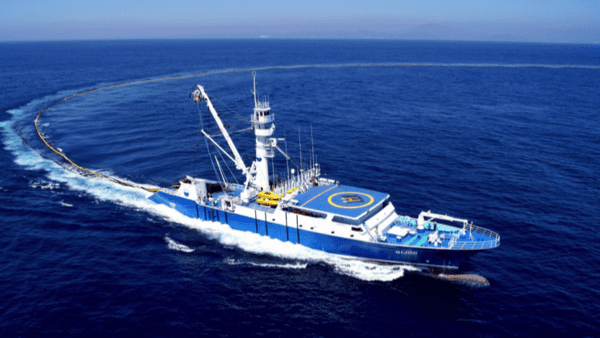
Closing the Purse Line
The fish master, in consultation with other team members, decides when to close the purse line, drawing the bottom of the net closed and trapping the tuna.
Hauling In the Catch
Skilled winch operators carefully haul in the catch, bringing the entire school of tuna to the surface while maintaining the integrity of the net and ensuring the safety of the crew.
Transfer and Storage
The caught tuna are transferred to the vessel’s hold or refrigerated compartments to maintain their freshness and quality.
How to choose the purse seine
If you have the purse seiner and skilled fishing team, now you might consider how to choose the suitable purse seine netting.
The most important thing of purse seine net is the layout. The layout should be designed by professional designer. it should include the netting, size, floats, leads and ropes.
Netting
Tuna purse seines are typically constructed from strong and durable materials such as nylon or polyester. These materials are chosen for their ability to withstand the force of capturing large and powerful tuna.

The most popular type of fishing net used as purse seine is nylon or polyester knotless net. Because knotless net is smooth on the surface, which can protect the fish from the damage of the nets.
Some fishermen also prefer the knotted net, it has higher abrasion. The nylon or polyester is soft enough to reduce the damage to the fish in the fishing.
Size
Tuna purse seines are quite large, with varying dimensions depending on the specific fishing vessel and the size of the target tuna species. They can range from hundreds to thousands of meters in length and may have a depth of several meters.
You should consider the power of your vessel, because the vessel should be powerful to load all the weight of fishing net and fish. The power is bigger, the size of purse seine could be larger.
Floats and Float Lines
The top edge of the purse seine is equipped with a line of floating devices known as “floats” or “corks.” These floats keep the upper part of the net afloat on the water’s surface, forming a barrier that encircles the school of tuna.

The most popular material of floats could be PVC or EVA. The PVC is harder and cheaper, while the EVA has better buoyant and is softer and more expensive.
The layout should consider the total buoyant of the floats, it must make sure that the total purse seine net could be floated on the surface of water during fishing.
Lead Lines
The bottom edge of the net is weighted with lead lines. These lead lines are essential for sinking the bottom of the net beneath the water’s surface and ensuring that the entire school of tuna is enclosed within the net.
It could be lead lines, it also could be installed by leads every several meters apart.
The swimming speed of tuna is very high, to keep the tuna from escaping, the sinking speed of purse seine net should be as fast as possible.
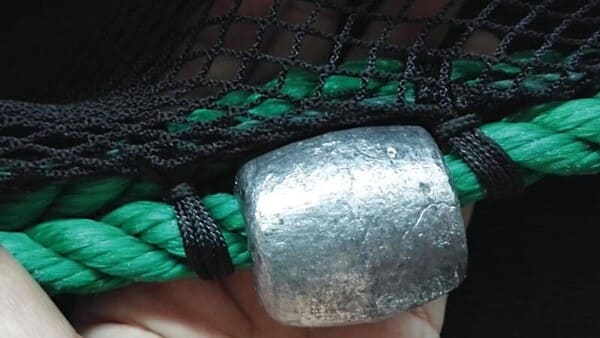
The total weight of leads is heavier, the sinking speed of purse seine is faster. But the more leads will increase the total weight of the net, so you should increase the quantity of floats to make sure that the net could be floated on the water. All of this will increase the cost of the purse seine net. You should balance all the factors in the layout.
Purse Line
A key feature of the purse seine is the “purse line.” This is a specialized line threaded through the bottom of the net, allowing it to be drawn closed like a drawstring purse. The purse line is attached to winches or hydraulic systems on the fishing vessel.
It should be strong enough, it could be made of PE, PP, polyester or nylon, the diameter could be 12-24mm as requirements.
How to produce the purse seine
The purse seine net is a very large net with the ropes, floats and leads. To produce this kind of fishing net is also not an easy work.
Prepare the material
At first, you should calculate the quantity of nets, ropes, leads and floats based on the layout. Then you should produce all the materials in advance.
Cutting and sewing the net
The fishing net is produced by pieces, the size is small. You should cut them into correct size and sew them together piece by piece. The specifications of fishing net are different, all the nets should be sewed together as the layout.
Install the floats and leads
The floats on the top and leads on the bottom should be installed on the rope, and all of them should be connected with the nets. All the selvages and sewing need be reinforced to make sure the whole purse seine net could be strong enough to withstand the impact during fishing.

Producing a seine net can be a complex and time-consuming process that often requires experience in net making. There are also specialized net manufacturers who produce seine nets for commercial fishing operations.
Where to buy
If you are not experienced in net making, it is advisable to seek assistance from professionals or purchase ready-made seine nets from reputable suppliers to ensure the quality and effectiveness of the net for your specific fishing needs.
If you want to buy purse seine net, you should consider several factors of manufacturers.
Reputation and Experience
Look for manufacturers with a solid reputation and a history of producing high-quality fishing gear, including purse seine nets.
Research the manufacturer’s background, years of experience, and the markets they serve.
Quality and Materials
Inquire about the materials used in the construction of their purse seine nets. The choice of netting material, floats, lead lines, and other components is critical for durability and performance.
Ask for information about their quality control processes to ensure that their nets meet industry standards and regulations. You also could ask for free sample to check the quality of the nets and other materials.
Customization Options
Determine if the manufacturer offers customization options for purse seine nets. The ability to tailor the net to your specific needs, such as size, mesh size, and design, is valuable.
Cost and Value
Compare prices and value for money. While cost is a factor, it should not be the sole determining factor. Consider the net’s quality, durability, and longevity when evaluating costs.
Visit the Facility
If feasible, visit the manufacturer’s facility to inspect their operations, quality control processes, and the materials they use.

If you don’t have enough time to visit, you should ask for the photos and videos of facility in production, then you can also see all the details.
Nettingland is focus on the netting in fishing for over 30 years, we also have rich experience of making completed fishing net, such as purse seine net, trawling net, fish cage and gill net.
If you have any questions or need the proposal for purse seine net, you could contact us at any time.
Conclusion
Purse seine fishing is an efficient method for capturing large quantities of tuna in a single haul. It is widely used in commercial tuna fishing, especially for species like skipjack tuna.
However, responsible fishing practices and conservation efforts are essential to ensure the sustainability of tuna populations and minimize the impact on the marine ecosystem.
Sustainable development is the responsibility of all of us in fishing industry. We must reduce the bycatch and overfishing in the commercial fishing activities.

